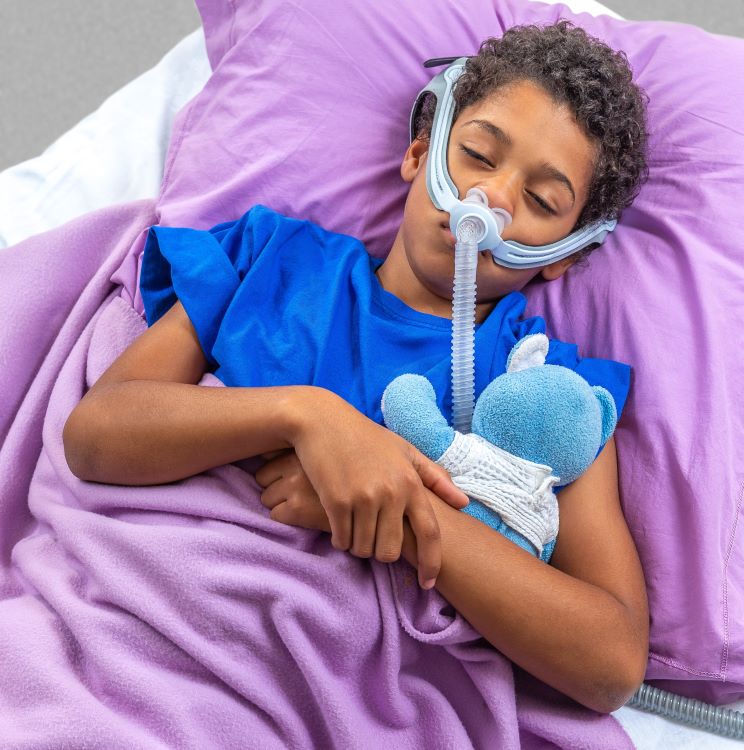A Comprehensive Analysis: Sleep Apnea in Youth and Adolescents

Sleep apnea, a common yet frequently unaddressed sleep disorder in youth and adolescents, can profoundly affect health and daily life. This blog delves deep into pediatric sleep apnea, the symptoms, risk contributors, diagnoses, treatment modalities, and the repercussions on cognition and conduct.
Nighttime and Daytime Indications of Sleep Apnea
Sleep apnea manifests distinct clinical characteristics in youngsters and adolescents. A hallmark of this condition is recurrent nocturnal arousal, frequently accompanied by breathlessness or snores. Sleep disruptions of this nature may lead to diurnal lethargy, irrespective of extended sleep duration. However, tiredness is not the sole concern. The condition may lead to learning impediments and behavior issues.
Root Factors and Their Consequences
An array of elements can make children susceptible to sleep apnea. These encompass genetic predisposition to the disorder, childhood body fat, and health disorders such as Down Syndrome and neuromuscular anomalies. Allergens may also contribute to developing sleep apnea. It’s important to recognize and intervene to circumvent the onset of sleep apnea.
How to Get a Diagnosis
The diagnosis of sleep apnea requires a gamut of procedures intended to form a comprehensive understanding of the child’s well-being. An exhaustive physical inspection and anamnesis form the pillars of this process. Polysomnography, or sleep study, gauges diverse bodily functions during sleep, including cerebral operations, ocular movements, cardiac rhythm, and blood pressure. Further assessments such as oximetry, lateral neck radiography, and upper respiratory tract evaluation might also be deployed to substantiate the diagnosis.
Pediatric Sleep Apnea Treatment
The therapeutic approach to sleep apnea is individualized, considering the child’s age, overall health status, and the severity of the condition. Positive Airway Pressure (PAP) therapy, a prevalent treatment modality, employs an apparatus that propels pressurized air via a mask to maintain open airways. Dental appliances, lifestyle alterations, pharmaceuticals, or surgical interventions may be deemed appropriate for effective condition management in specific scenarios.
How Sleep Apnea Affects Children
Sleep apnea can significantly affect a child’s academic performance and behavior. Disturbed sleep may undermine concentration abilities, culminating in declining academic performance. The condition may also exacerbate ADHD manifestations and provoke mood fluctuations, irritability, and social introversion, underscoring the need for robust support mechanisms at educational institutions and at home.
Sleep apnea in youth and adolescents is an urgent matter that calls for vigilance. By elucidating its symptoms, acknowledging the risk factors, and advocating for early diagnosis and efficacious treatment, we can mitigate its impact on the affected child’s cognitive function and behavior, thereby enhancing their life quality.
Key Points:
- Sleep apnea in youth and adolescents has distinctive symptoms, such as recurrent nocturnal arousal, diurnal lethargy, and conduct irregularities.
- Many risk elements, spanning genetic and environmental factors, can make children susceptible to sleep apnea.
- Diagnostic methodologies like physical inspections, sleep studies, and anamnesis are pivotal in diagnosing sleep apnea.
- An assortment of treatment options exists, extending from PAP therapy to surgical interventions, contingent on the severity of the condition.
- Sleep apnea can significantly influence a child’s cognitive function and behavior, underscoring the urgency for timely intervention and robust support mechanisms.
FAQs about Sleep Apnea
Q: Could you define sleep apnea?
A: Sleep apnea is a common but often disregarded sleep disorder in children and adolescents. This condition results in repeated cessation of breathing during sleep, creating numerous sleep disruptions, leading to chronic daytime lethargy, and potentially impinging upon learning and behavioral health.
Q: What signs might indicate sleep apnea in children?
A: Frequent disturbances during nighttime sleep, often accompanied by gasping or choking, persistent daytime drowsiness, snoring, and noticeable breathing pauses during sleep, signify this disorder. Further symptoms may encompass nocturnal enuresis and learning impediments.
Q: How do healthcare professionals diagnose sleep apnea in children?
A: Diagnosing sleep apnea incorporates several methods, including a comprehensive physical evaluation and a diagnostic sleep study. Additional investigative measures like oximetry and upper airway assessment might also be used.
Q: How might sleep apnea influence a child’s educational performance and behavior?
A: Sleep apnea can significantly disrupt a child’s academic achievements and behavior, intensify ADHD manifestations, and incite mood fluctuations, irritability, and introverted behaviors.
Parkway Sleep Center
Is your child having a difficult time getting a restful night’s sleep? Parkway Sleep Center can help. Our team will thoroughly evaluate your child and recommend a treatment plan. Contact us today at 919-439-3463 and schedule an appointment. See the improvement in your child’s behavior and school performance once they get optimal sleep.



